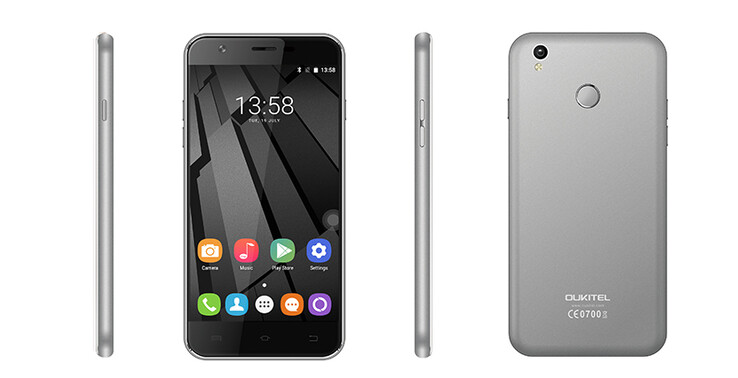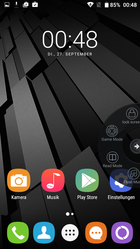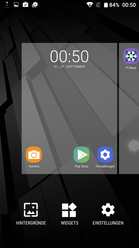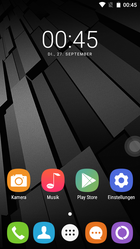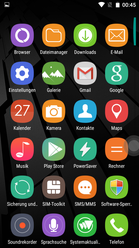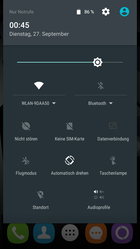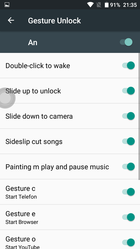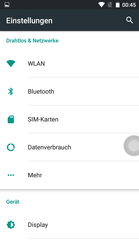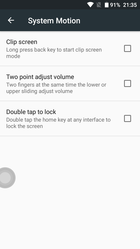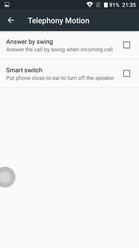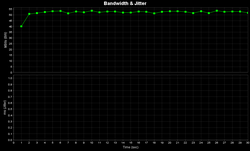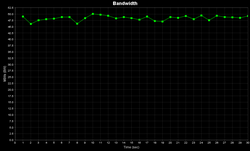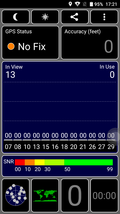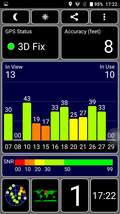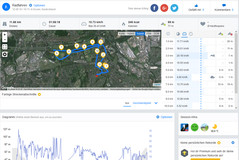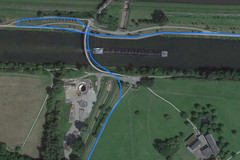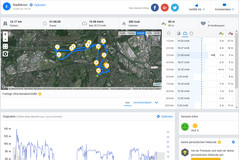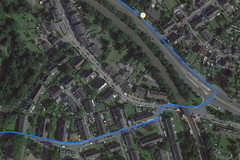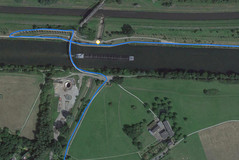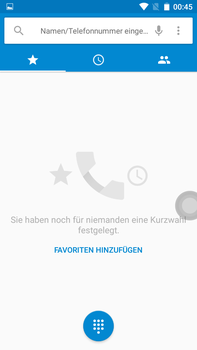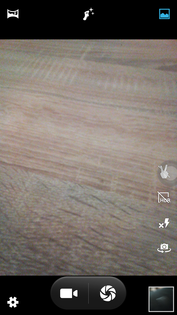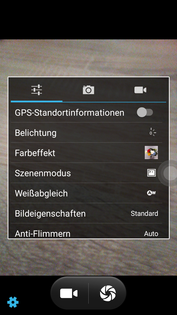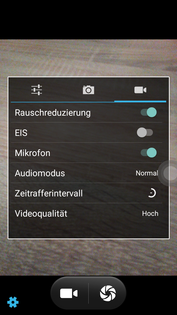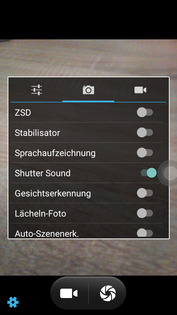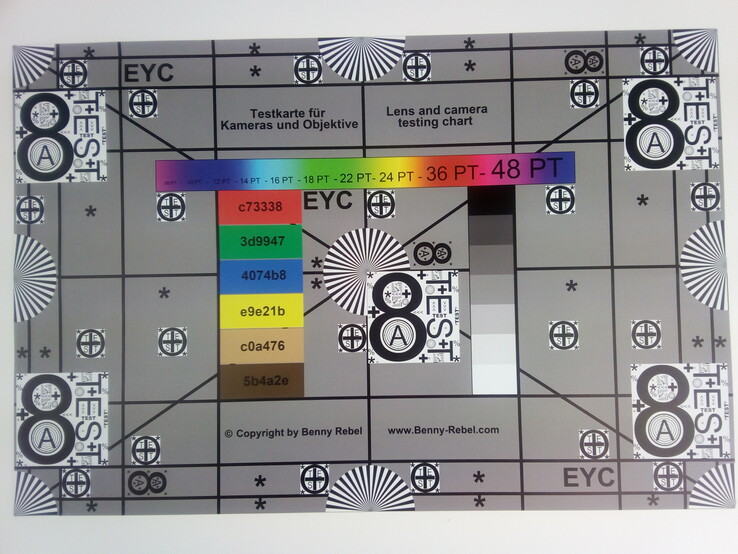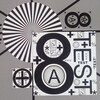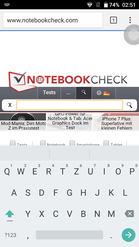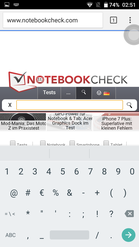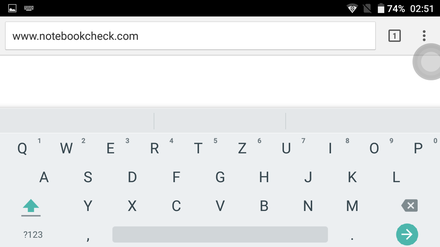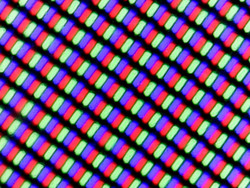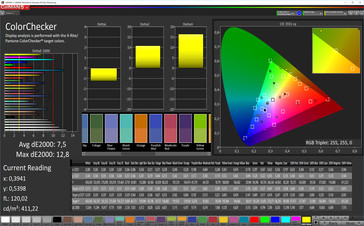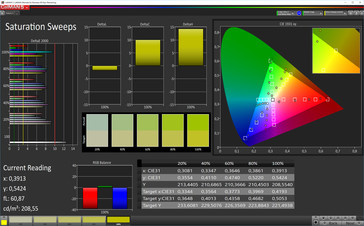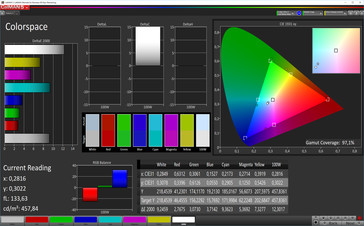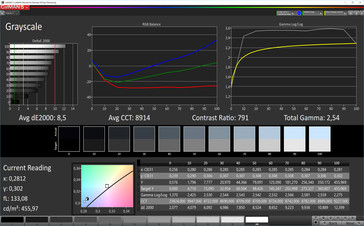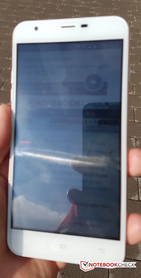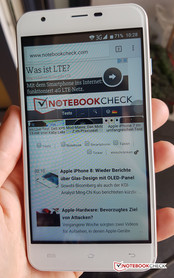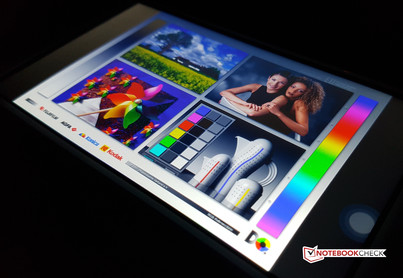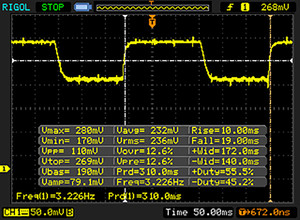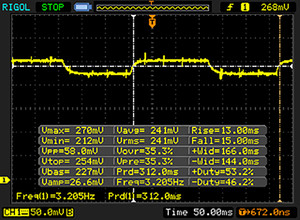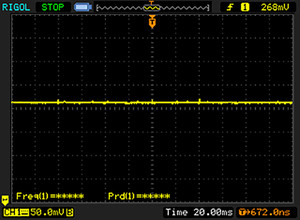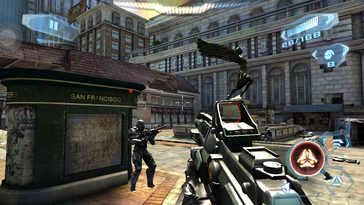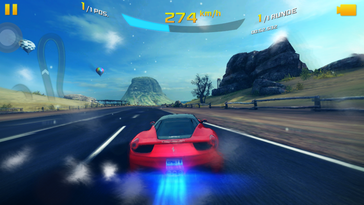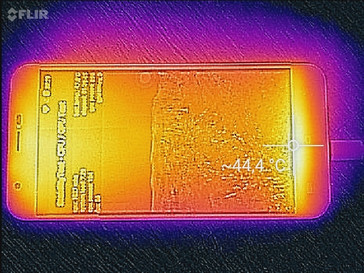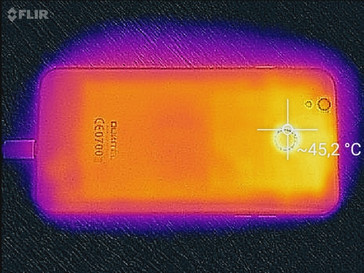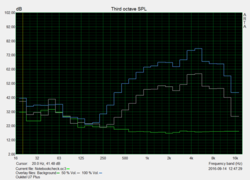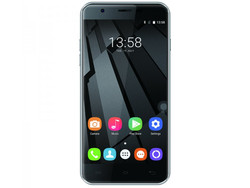Oukitel U7 Plus Smartphone Review
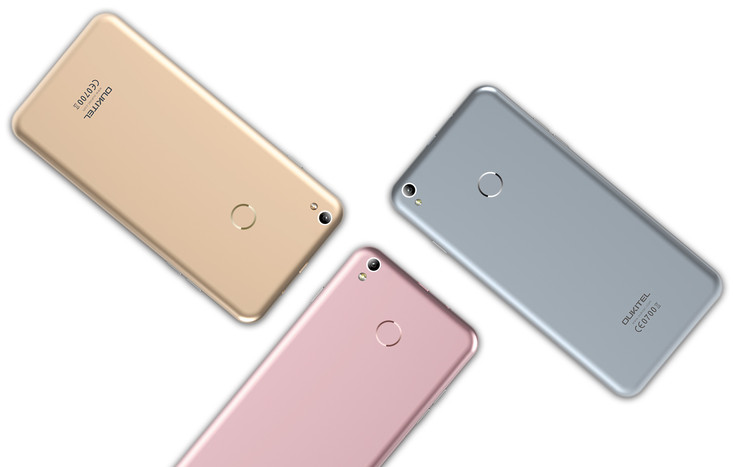
For the original German review, see here.
Despite its low purchase price, the technical configuration of Oukitel's U7 Plus is promising. The Chinese manufacturer Oukitel, relatively unknown in Germany, incorporates an HD IPS panel, a quad-core CPU by MediaTek, 16 GB of internal storage, and a removable battery with a capacity of 2500 mAh besides an active fingerprint scanner into its entry-level device. The working memory of 2 GB RAM is very decent considering the price range.
Oukitel's smartphone presents some better technical specs with this hardware than some "considerably" more expensive entry-level handsets by other manufacturers despite its low street price. We would name, for example, Wiko's Jerry, Archos' 50 Platinum 4G, TP Link's Neffos C5, Huawei's Y5 II or Coolpad's Porto S. Also higher-priced but with better technical equipment, UMI's Touch or UleFone's Metal could also be possible alternatives for Oukitel's U7 Plus. Although the low-budget handset's outdated TFT panel excludes it as an alternative, Archos' 50e Neon is also listed as a comparison device due to its similar purchase price.
Case
The plastic casing is available in "Space Gray", "Rose Gold", and "Champagne Gold". The looks of Oukitel's U7 Plus resembles that of the correspondingly 5.5-inch Apple iPhone Plus. In line with this, the Chinese manufacturer's entry-level smartphone features wide bezels around the screen like its popular rival from Cupertino. Expressed in figures: Only 67.5 percent of the front are reserved for the screen - actually too little for a phablet and no longer contemporary. Nor is the weight of 198 grams (~7 oz) very typical for a smartphone, even if Apple's counterpart is within a similar category (192 grams/~6.8 oz). The device's overall handiness is limited and rather unsuitable for users with small hands.
The build and feel are on a good level considering the price. The controls for volume and power present a solid build and well-defined pressure points. The casing's stiffness also makes a good impression. Despite the removable back cover, the produced noises (cracking) when handling the handset remain within acceptable limits. Furthermore, the glass front has a lightly curved 2.5D bezel.
Connectivity
With 16 GB of expandable, internal eMMC storage, Oukitel's U7 Plus offers quite a lot of capacity for storing data - by comparison, the rivals with 8 GB (Archos 50e Neon or Coolpad Porto S) often only have half the ROM size. The user has approximately 11.6 GB for personal use after deducting the operating system. The manufacturer supports moving apps to the micro-SD card (App2SD).
The smartphone is recharged via a micro-USB 2.0 port on the handset's lower edge. USB OTG (on the go) for connecting external storage devices or peripherals is not supported. Beyond that, a three-colored notification LED and a fingerprint scanner are installed.
Software
Oukitel relies on the relatively up-to-date Google Android version 6.0 Marshmallow as system software. However, modifications have been made to both the software and looks of the operating system's user interface. The manufacturer's UI still visibly corresponds to Google's stock Android in the settings menu, but the app and folder design follows Oukitel's design language.
Besides the visible modifications made to the user interface, Oukitel's U7 Plus has some additional software features such as gesture recognition. This allows launching applications while the screen is off. For example, the letter "o" is drawn on the disabled screen for opening YouTube directly. Gesture recognition functioned reliably on our review sample.
Communication and GPS
Oukitel's U7 Plus allows using up to two micro-SIM cards simultaneously. The inexpensive smartphone accesses mobile Internet at agreeably fast speeds of up to 150 MB/s in download and 50 MB/s in upload (LTE Cat4) - this is the case with both SIM card slots. However, the frequency coverage is relatively low especially in the GSM and UMTS standards - quad-band GSM and dual-band UMTS are supported. Although the U7 Plus was not intended for the German market, the LTE coverage can be guaranteed in all frequency bands (3, 7, 20) relevant in Germany. Bluetooth version 4.0 is present for wireless near field communication - as expected in the price range, an NFC chip is not installed.
The integrated Wi-Fi module only supports the IEEE 802.11 b/g/n standards and transmits in the 2.4 GHz frequency range. Our review sample's Wi-Fi signal was not always stable during the test period (occasional connection interruptions), but the signal strength was throughout on par with that of the rivals. We measured an attenuation of -41 dBm in the router's direct vicinity (Telekom Speedport, W921V). The average transmission rates one meter (~3 ft) away from the router (Linksys EA8500) were satisfactory at 52 Mbit/s (transmit) and 48 Mbit/s (receive).
| Networking | |
| iperf Server (receive) TCP 1 m | |
| Lenovo Moto Z | |
| Ulefone Metal | |
| Archos 50 Platinum 4G | |
| Huawei Y5 II | |
| Oukitel U7 Plus | |
| TP-Link Neffos C5 | |
| Archos 50e Neon | |
| iperf Client (transmit) TCP 1 m | |
| Lenovo Moto Z | |
| Ulefone Metal | |
| Huawei Y5 II | |
| Oukitel U7 Plus | |
| TP-Link Neffos C5 | |
| Archos 50 Platinum 4G | |
| Archos 50e Neon | |
The GPS module in Oukitel's U7 Plus quickly and reliably found our current position with an accuracy of approximately 3 meters (~10 ft). It could not locate us indoors. The U7 Plus presents a deviation of 310 meters (~340 yards) in our practical test where we record a route using the entry-level smartphone's GPS module and Garmin's Edge 500 bike computer simultaneously. The accuracy of the smartphone's GPS module is average in total.
Telephone and Call Quality
The call quality using the incorporated earpiece can be called good. Voices are transmitted clearly, and our contact described us as clear. Annoying interruptions or reception issues did not develop in the test calls via the German Vodafone network. In contrast to the earpiece, the clarity using the speaker is somewhat worse. It suffers from a too quiet and slightly distorted reproduction of conversations.
The phone app corresponds to the stock Android 6.0 solution. In addition to a quick-dial feature, the application offers call lists and direct access to saved contacts.
Cameras
The CMOS sensor of the rear-facing primary camera has a resolution of 8 megapixels (3265x2448 pixels) and is interpolated to 13 MP via software. The primary camera's photos offer little dynamic and thus very bright scenes darken too strongly and details can hardly be recognized (scene 2, river). Furthermore, the photos look quite blurred. The 8-MP camera finds its limits in varying light conditions (shade, sun) - sometimes exposure issues develop here (scene 1, woods). Details are hardly visible in dark surroundings, and the photos display a visible blurriness (scene 3, street). In total, the quality is acceptable for a handset from this price range. However, UMi's Touch provides much better camera performance for a relatively small surcharge.
The front-facing camera also has a CMOS image sensor with a resolution of 2 MP. Like in the primary camera, the lens' native resolution is raised via interpolation (5 MP). The photos are satisfactory for an entry-level smartphone although the quality is not very high. The front-facing camera is quite suitable for snapshots and videoconferencing. The rear-facing camera records videos at 720p.
Accessories and Warranty
In addition to the smartphone, a quick start guide, modular 5-watt power supply (1A, 5V), and USB charger cable are in the box. Beyond that, a screen protector is applied ex-factory. Headphones are not included.
Oukitel includes a global warranty period of 12 months on its smartphones (not accessories). Please see our Guarantees, Return Policies & Warranties FAQ for country-specific information.
Input Devices and Handling
Google's stock keyboard in Android Marshmallow design is preloaded for onscreen inputting. The multi-touchscreen (2 fingers) responds accurately to inputs and the glass surface provides pleasant gliding qualities. The active 360° fingerprint scanner on the smartphone's rear is well positioned and unlocking the handset via biometric identification with a fingerprint functions reliably. The sensor is not the fastest one on the market, but the manufacturer states that the handset is unlocked in 0.2 seconds.
The power button on the casing's right and the unlit, capacitive keys below the screen for navigating through the Android system do not offer much convenience as they have been positioned too high.
Display
The IPS LCD screen has a diagonal of almost 14 centimeters (5.5 inches). At a resolution of 1280x720 pixels, this equals a pixel density of 265 PPI. Thus, small fonts, in particular, look blurred in texts, and pixel structures are visible at a normal viewing distance. However, the achieved pixels per inch do not interfere with everyday use.
The LED backlight shines quite brightly at up to 462 cd/m² in the screen's center. The realistic APL50 test (average picture level) with equally distributed bright and dark areas results in a similar maximum brightness of 460 cd/m². The maximum brightness increases to 480 cd/m² when the brightness sensor is enabled.
| |||||||||||||||||||||||||
Brightness Distribution: 91 %
Center on Battery: 462 cd/m²
Contrast: 797:1 (Black: 0.58 cd/m²)
ΔE ColorChecker Calman: 7.5 | ∀{0.5-29.43 Ø4.78}
ΔE Greyscale Calman: 8.5 | ∀{0.09-98 Ø5}
Gamma: 2.54
CCT: 8914 K
| Oukitel U7 Plus IPS, 1280x720, 5.5" | Ulefone Metal IPS, 1280x720, 5" | TP-Link Neffos C5 IPS, 1280x720, 5" | Coolpad Porto S IPS, 1280x720, 5" | Huawei Y5 II IPS, 1280x720, 5" | Wiko Jerry IPS, 854x480, 5" | Archos 50 Platinum 4G IPS, 1280x720, 5" | Archos 50e Neon TFT, 854x480, 5" | UMI Touch IPS, 1920x1080, 5.5" | Lenovo Moto Z AMOLED, 2560x1440, 5.5" | |
|---|---|---|---|---|---|---|---|---|---|---|
| Screen | -9% | 7% | -7% | -13% | 2% | -3% | -30% | 4% | 36% | |
| Brightness middle (cd/m²) | 462 | 312 -32% | 508 10% | 407 -12% | 465 1% | 432 -6% | 344 -26% | 443 -4% | 424 -8% | 485 5% |
| Brightness (cd/m²) | 437 | 315 -28% | 491 12% | 403 -8% | 443 1% | 436 0% | 349 -20% | 430 -2% | 415 -5% | 490 12% |
| Brightness Distribution (%) | 91 | 87 -4% | 89 -2% | 92 1% | 90 -1% | 91 0% | 89 -2% | 94 3% | 91 0% | 92 1% |
| Black Level * (cd/m²) | 0.58 | 0.56 3% | 0.58 -0% | 0.5 14% | 0.84 -45% | 0.57 2% | 0.65 -12% | 0.38 34% | 0.54 7% | |
| Contrast (:1) | 797 | 557 -30% | 876 10% | 814 2% | 554 -30% | 758 -5% | 529 -34% | 1166 46% | 785 -2% | |
| Colorchecker dE 2000 * | 7.5 | 6.8 9% | 7 7% | 7.9 -5% | 7.8 -4% | 7 7% | 5.8 23% | 13.9 -85% | 6.9 8% | 2.1 72% |
| Colorchecker dE 2000 max. * | 12.8 | 14 -9% | 14.1 -10% | 18.2 -42% | 15.7 -23% | 12.4 3% | 10.7 16% | 29.5 -130% | 10.9 15% | 5.5 57% |
| Greyscale dE 2000 * | 8.5 | 7.1 16% | 6.1 28% | 8.9 -5% | 8.4 1% | 7.6 11% | 5.7 33% | 17.3 -104% | 6.8 20% | 2.6 69% |
| Gamma | 2.54 87% | 2.77 79% | 2.15 102% | 2.46 89% | 2.07 106% | 2.1 105% | 2.1 105% | 2.93 75% | 1.99 111% | 2.23 99% |
| CCT | 8914 73% | 7402 88% | 8068 81% | 8332 78% | 8438 77% | 8368 78% | 7792 83% | 22878 28% | 8131 80% | 6843 95% |
| Color Space (Percent of AdobeRGB 1998) (%) | 88.14 | |||||||||
| Color Space (Percent of sRGB) (%) | 100 |
* ... smaller is better
The screen's brightness in conjunction with the black level of 0.58 cd/m² (APL50: 0.6 cd/m²) results in a decent contrast ratio of 797:1. The screen analysis with a photospectrometer and CalMAN software exhibits clear aberrations in some colors (7.5) and grayscale levels (8.5). Furthermore, the measured color temperature of 8914 Kelvin is too cool - this results in a light bluish tint in practice.
Display Response Times
| ↔ Response Time Black to White | ||
|---|---|---|
| 29 ms ... rise ↗ and fall ↘ combined | ↗ 10 ms rise | |
| ↘ 19 ms fall | ||
| The screen shows relatively slow response rates in our tests and may be too slow for gamers. In comparison, all tested devices range from 0.1 (minimum) to 240 (maximum) ms. » 76 % of all devices are better. This means that the measured response time is worse than the average of all tested devices (20.2 ms). | ||
| ↔ Response Time 50% Grey to 80% Grey | ||
| 28 ms ... rise ↗ and fall ↘ combined | ↗ 13 ms rise | |
| ↘ 15 ms fall | ||
| The screen shows relatively slow response rates in our tests and may be too slow for gamers. In comparison, all tested devices range from 0.165 (minimum) to 636 (maximum) ms. » 36 % of all devices are better. This means that the measured response time is better than the average of all tested devices (31.6 ms). | ||
Screen Flickering / PWM (Pulse-Width Modulation)
| Screen flickering / PWM not detected | |||
In comparison: 53 % of all tested devices do not use PWM to dim the display. If PWM was detected, an average of 8111 (minimum: 5 - maximum: 343500) Hz was measured. | |||
Performance
MediaTek's MT6737 processor installed in Oukitel's U7 Plus is an entry-level ARM SoC (system on a chip) from 2016. It is built in 28 nanometers, has four CPU cores based on the 64-bit capable Cortex A53 architecture, and clocks at a maximum of 1.25 GHz in Oukitel's smartphone. Alongside 2 GB of RAM, the entry-level handset presents a subjectively decent performance. Multitasking causes system lags and stutters, but the system runs smoothly in "normal" everyday use. Although the browser performance using the preloaded Google Chrome browser is not the fastest, it is satisfactory for the price range.
Oukitel's U7 Plus is in the midfield of the ratings in the benchmarks we tested - at least in processor-driven tests. When the low-performance Mali-T720 GPU is also loaded, our comparison devices take a clear lead and manage considerably higher frames per second in the GFXBench benchmark.
The flash memory's speed is relatively slow especially when reading and writing small 4 KB data blocks. In contrast to that, the read and write access speeds on a micro-SD card (reference card: Toshiba Exceria Pro M401; max. read: 95 MB/s, write 80 MB/s) are good for an entry-level handset and only UleFone's Metal surpasses them.
| AndroBench 3-5 | |
| Sequential Write 256KB SDCard (sort by value) | |
| Oukitel U7 Plus | |
| Ulefone Metal | |
| TP-Link Neffos C5 | |
| Huawei Y5 II | |
| Wiko Jerry | |
| Archos 50 Platinum 4G | |
| UMI Touch | |
| Lenovo Moto Z | |
| Sequential Read 256KB SDCard (sort by value) | |
| Oukitel U7 Plus | |
| Ulefone Metal | |
| TP-Link Neffos C5 | |
| Huawei Y5 II | |
| Wiko Jerry | |
| Archos 50 Platinum 4G | |
| UMI Touch | |
| Lenovo Moto Z | |
| Random Write 4KB (sort by value) | |
| Oukitel U7 Plus | |
| Ulefone Metal | |
| TP-Link Neffos C5 | |
| Coolpad Porto S | |
| Huawei Y5 II | |
| Wiko Jerry | |
| Archos 50 Platinum 4G | |
| UMI Touch | |
| Lenovo Moto Z | |
| Random Read 4KB (sort by value) | |
| Oukitel U7 Plus | |
| Ulefone Metal | |
| TP-Link Neffos C5 | |
| Coolpad Porto S | |
| Huawei Y5 II | |
| Wiko Jerry | |
| Archos 50 Platinum 4G | |
| UMI Touch | |
| Lenovo Moto Z | |
| Sequential Write 256KB (sort by value) | |
| Oukitel U7 Plus | |
| Ulefone Metal | |
| TP-Link Neffos C5 | |
| Coolpad Porto S | |
| Huawei Y5 II | |
| Wiko Jerry | |
| Archos 50 Platinum 4G | |
| UMI Touch | |
| Lenovo Moto Z | |
| Sequential Read 256KB (sort by value) | |
| Oukitel U7 Plus | |
| Ulefone Metal | |
| TP-Link Neffos C5 | |
| Coolpad Porto S | |
| Huawei Y5 II | |
| Wiko Jerry | |
| Archos 50 Platinum 4G | |
| UMI Touch | |
| Lenovo Moto Z | |
| AnTuTu v6 - Total Score (sort by value) | |
| Oukitel U7 Plus | |
| Ulefone Metal | |
| TP-Link Neffos C5 | |
| Coolpad Porto S | |
| Huawei Y5 II | |
| Wiko Jerry | |
| Archos 50 Platinum 4G | |
| UMI Touch | |
| Lenovo Moto Z | |
| 3DMark | |
| 1280x720 offscreen Ice Storm Unlimited Score (sort by value) | |
| Oukitel U7 Plus | |
| Ulefone Metal | |
| TP-Link Neffos C5 | |
| Coolpad Porto S | |
| Huawei Y5 II | |
| Wiko Jerry | |
| Archos 50 Platinum 4G | |
| UMI Touch | |
| Lenovo Moto Z | |
| 1280x720 offscreen Ice Storm Unlimited Graphics Score (sort by value) | |
| Oukitel U7 Plus | |
| Ulefone Metal | |
| TP-Link Neffos C5 | |
| Coolpad Porto S | |
| Huawei Y5 II | |
| Wiko Jerry | |
| Archos 50 Platinum 4G | |
| UMI Touch | |
| Lenovo Moto Z | |
| 1280x720 offscreen Ice Storm Unlimited Physics (sort by value) | |
| Oukitel U7 Plus | |
| Ulefone Metal | |
| TP-Link Neffos C5 | |
| Coolpad Porto S | |
| Huawei Y5 II | |
| Wiko Jerry | |
| Archos 50 Platinum 4G | |
| UMI Touch | |
| Lenovo Moto Z | |
| 2560x1440 Sling Shot OpenGL ES 3.0 (sort by value) | |
| Oukitel U7 Plus | |
| Ulefone Metal | |
| TP-Link Neffos C5 | |
| Huawei Y5 II | |
| UMI Touch | |
| Lenovo Moto Z | |
| 2560x1440 Sling Shot OpenGL ES 3.0 Graphics (sort by value) | |
| Oukitel U7 Plus | |
| Ulefone Metal | |
| TP-Link Neffos C5 | |
| Huawei Y5 II | |
| UMI Touch | |
| Lenovo Moto Z | |
| 2560x1440 Sling Shot OpenGL ES 3.0 Physics (sort by value) | |
| Oukitel U7 Plus | |
| Ulefone Metal | |
| TP-Link Neffos C5 | |
| Huawei Y5 II | |
| UMI Touch | |
| Lenovo Moto Z | |
| GFXBench (DX / GLBenchmark) 2.7 | |
| T-Rex Onscreen (sort by value) | |
| Oukitel U7 Plus | |
| Ulefone Metal | |
| TP-Link Neffos C5 | |
| Coolpad Porto S | |
| Huawei Y5 II | |
| Wiko Jerry | |
| Archos 50 Platinum 4G | |
| UMI Touch | |
| Lenovo Moto Z | |
| 1920x1080 T-Rex Offscreen (sort by value) | |
| Oukitel U7 Plus | |
| Ulefone Metal | |
| TP-Link Neffos C5 | |
| Coolpad Porto S | |
| Huawei Y5 II | |
| Wiko Jerry | |
| Archos 50 Platinum 4G | |
| UMI Touch | |
| Lenovo Moto Z | |
| GFXBench 3.0 | |
| on screen Manhattan Onscreen OGL (sort by value) | |
| Oukitel U7 Plus | |
| Ulefone Metal | |
| TP-Link Neffos C5 | |
| Coolpad Porto S | |
| Huawei Y5 II | |
| Archos 50 Platinum 4G | |
| UMI Touch | |
| Lenovo Moto Z | |
| 1920x1080 1080p Manhattan Offscreen (sort by value) | |
| Oukitel U7 Plus | |
| Ulefone Metal | |
| TP-Link Neffos C5 | |
| Coolpad Porto S | |
| Huawei Y5 II | |
| Archos 50 Platinum 4G | |
| UMI Touch | |
| Lenovo Moto Z | |
| GFXBench 3.1 | |
| on screen Manhattan ES 3.1 Onscreen (sort by value) | |
| Oukitel U7 Plus | |
| Ulefone Metal | |
| Huawei Y5 II | |
| Archos 50 Platinum 4G | |
| UMI Touch | |
| Lenovo Moto Z | |
| 1920x1080 Manhattan ES 3.1 Offscreen (sort by value) | |
| Oukitel U7 Plus | |
| Ulefone Metal | |
| Huawei Y5 II | |
| Archos 50 Platinum 4G | |
| UMI Touch | |
| Lenovo Moto Z | |
| PCMark for Android - Work performance score (sort by value) | |
| Oukitel U7 Plus | |
| Ulefone Metal | |
| TP-Link Neffos C5 | |
| Coolpad Porto S | |
| Huawei Y5 II | |
| Wiko Jerry | |
| Archos 50 Platinum 4G | |
| UMI Touch | |
| Lenovo Moto Z | |
| BaseMark OS II | |
| Overall (sort by value) | |
| Oukitel U7 Plus | |
| Ulefone Metal | |
| TP-Link Neffos C5 | |
| Coolpad Porto S | |
| Huawei Y5 II | |
| Wiko Jerry | |
| Archos 50 Platinum 4G | |
| UMI Touch | |
| Lenovo Moto Z | |
| System (sort by value) | |
| Oukitel U7 Plus | |
| Ulefone Metal | |
| TP-Link Neffos C5 | |
| Coolpad Porto S | |
| Huawei Y5 II | |
| Wiko Jerry | |
| Archos 50 Platinum 4G | |
| UMI Touch | |
| Lenovo Moto Z | |
| Memory (sort by value) | |
| Oukitel U7 Plus | |
| Ulefone Metal | |
| TP-Link Neffos C5 | |
| Coolpad Porto S | |
| Huawei Y5 II | |
| Wiko Jerry | |
| Archos 50 Platinum 4G | |
| UMI Touch | |
| Lenovo Moto Z | |
| Graphics (sort by value) | |
| Oukitel U7 Plus | |
| Ulefone Metal | |
| TP-Link Neffos C5 | |
| Coolpad Porto S | |
| Huawei Y5 II | |
| Wiko Jerry | |
| Archos 50 Platinum 4G | |
| UMI Touch | |
| Lenovo Moto Z | |
| Web (sort by value) | |
| Oukitel U7 Plus | |
| Ulefone Metal | |
| TP-Link Neffos C5 | |
| Coolpad Porto S | |
| Huawei Y5 II | |
| Wiko Jerry | |
| Archos 50 Platinum 4G | |
| UMI Touch | |
| Lenovo Moto Z | |
| Geekbench 4.0 | |
| 64 Bit Multi-Core Score (sort by value) | |
| Oukitel U7 Plus | |
| Ulefone Metal | |
| Huawei Y5 II | |
| Archos 50 Platinum 4G | |
| Lenovo Moto Z | |
| 64 Bit Single-Core Score (sort by value) | |
| Oukitel U7 Plus | |
| Ulefone Metal | |
| Huawei Y5 II | |
| Archos 50 Platinum 4G | |
| Lenovo Moto Z | |
| Mozilla Kraken 1.1 - Total (sort by value) | |
| Oukitel U7 Plus | |
| Ulefone Metal | |
| TP-Link Neffos C5 | |
| Coolpad Porto S | |
| Huawei Y5 II | |
| Wiko Jerry | |
| Archos 50 Platinum 4G | |
| UMI Touch | |
| Lenovo Moto Z | |
| Octane V2 - Total Score (sort by value) | |
| Oukitel U7 Plus | |
| Ulefone Metal | |
| TP-Link Neffos C5 | |
| Coolpad Porto S | |
| Huawei Y5 II | |
| Wiko Jerry | |
| Archos 50 Platinum 4G | |
| UMI Touch | |
| Lenovo Moto Z | |
| JetStream 1.1 - Total Score (sort by value) | |
| Oukitel U7 Plus | |
| Ulefone Metal | |
| TP-Link Neffos C5 | |
| Coolpad Porto S | |
| Huawei Y5 II | |
| Wiko Jerry | |
| Archos 50 Platinum 4G | |
| UMI Touch | |
| Lenovo Moto Z | |
* ... smaller is better
Games
The SoC-integrated Mali-T720 (MP1) has one computing core that clocks at up to 600 MHz. Although games with high graphic requirements from the Android Play Store, such as "Asphalt 8: Airborne" or "N.O.V.A. 3", cannot be rendered smoothly, they can be played. The loading times are also relatively long - the slow flash memory takes its toll here. Control via touchscreen and position sensor functions well. However, it should be kept in mind that multi-touch games needing more than two fingers are not supported.
Emissions
Temperature
The surface temperatures during load are quite high. While the rates did not surpass 34.3 °C (rear/93.74 °F) when the handset was idling, over 42 °C (107.6 °F) were reached during permanent load. Some comparison devices present a much lower maximum temperature development here. However, the temperature development when idle is not, subjectively, disconcerting in everyday use.
(±) The maximum temperature on the upper side is 43.5 °C / 110 F, compared to the average of 35.2 °C / 95 F, ranging from 21.9 to 247 °C for the class Smartphone.
(±) The bottom heats up to a maximum of 42.1 °C / 108 F, compared to the average of 34 °C / 93 F
(±) In idle usage, the average temperature for the upper side is 35 °C / 95 F, compared to the device average of 32.9 °C / 91 F.
Speaker
The mono speaker's sound quality is in line with the price range, and it offers a sufficient sound for playing short YouTube videos. We measured a maximum volume of up to almost 82 dB(A) in the test, a decent rate that is sufficient for everyday use. The sound impression is treble-heavy and bass-free as expected. The Pink Noise diagram clearly illustrates that lower frequencies are hardly audible. Furthermore, super high tones of over 9 KHz are clearly underrepresented.
Oukitel U7 Plus audio analysis
(±) | speaker loudness is average but good (81.6 dB)
Bass 100 - 315 Hz
(-) | nearly no bass - on average 31.6% lower than median
(±) | linearity of bass is average (7.4% delta to prev. frequency)
Mids 400 - 2000 Hz
(±) | reduced mids - on average 6.1% lower than median
(±) | linearity of mids is average (9.1% delta to prev. frequency)
Highs 2 - 16 kHz
(±) | higher highs - on average 9.3% higher than median
(±) | linearity of highs is average (9.2% delta to prev. frequency)
Overall 100 - 16.000 Hz
(-) | overall sound is not linear (34.2% difference to median)
Compared to same class
» 84% of all tested devices in this class were better, 1% similar, 15% worse
» The best had a delta of 11%, average was 35%, worst was 134%
Compared to all devices tested
» 93% of all tested devices were better, 1% similar, 6% worse
» The best had a delta of 4%, average was 24%, worst was 134%
Ulefone Metal audio analysis
(±) | speaker loudness is average but good (76.4 dB)
Bass 100 - 315 Hz
(-) | nearly no bass - on average 25.6% lower than median
(-) | bass is not linear (15.5% delta to prev. frequency)
Mids 400 - 2000 Hz
(+) | balanced mids - only 3.7% away from median
(±) | linearity of mids is average (8.2% delta to prev. frequency)
Highs 2 - 16 kHz
(±) | higher highs - on average 5.6% higher than median
(+) | highs are linear (6.5% delta to prev. frequency)
Overall 100 - 16.000 Hz
(±) | linearity of overall sound is average (24.4% difference to median)
Compared to same class
» 58% of all tested devices in this class were better, 7% similar, 35% worse
» The best had a delta of 11%, average was 35%, worst was 134%
Compared to all devices tested
» 73% of all tested devices were better, 6% similar, 21% worse
» The best had a delta of 4%, average was 24%, worst was 134%
Coolpad Porto S audio analysis
(+) | speakers can play relatively loud (84.9 dB)
Bass 100 - 315 Hz
(-) | nearly no bass - on average 37.1% lower than median
(±) | linearity of bass is average (9.4% delta to prev. frequency)
Mids 400 - 2000 Hz
(±) | reduced mids - on average 5.2% lower than median
(±) | linearity of mids is average (8% delta to prev. frequency)
Highs 2 - 16 kHz
(+) | balanced highs - only 2.4% away from median
(+) | highs are linear (3.8% delta to prev. frequency)
Overall 100 - 16.000 Hz
(±) | linearity of overall sound is average (25% difference to median)
Compared to same class
» 61% of all tested devices in this class were better, 7% similar, 33% worse
» The best had a delta of 11%, average was 35%, worst was 134%
Compared to all devices tested
» 76% of all tested devices were better, 5% similar, 19% worse
» The best had a delta of 4%, average was 24%, worst was 134%
Wiko Jerry audio analysis
(+) | speakers can play relatively loud (85 dB)
Bass 100 - 315 Hz
(-) | nearly no bass - on average 31% lower than median
(±) | linearity of bass is average (8.1% delta to prev. frequency)
Mids 400 - 2000 Hz
(±) | reduced mids - on average 6.2% lower than median
(+) | mids are linear (6.8% delta to prev. frequency)
Highs 2 - 16 kHz
(+) | balanced highs - only 3.7% away from median
(+) | highs are linear (2.6% delta to prev. frequency)
Overall 100 - 16.000 Hz
(±) | linearity of overall sound is average (24.4% difference to median)
Compared to same class
» 58% of all tested devices in this class were better, 7% similar, 35% worse
» The best had a delta of 11%, average was 35%, worst was 134%
Compared to all devices tested
» 73% of all tested devices were better, 6% similar, 21% worse
» The best had a delta of 4%, average was 24%, worst was 134%
Frequency diagram in comparison (check boxes above can be turned on/off!)
Energy Management
Power Consumption
The consumption of Oukitel's U7 Plus is acceptable overall for a 5.5-inch smartphone - but the power consumption is not efficient. The power consumption of the smaller 5-inch screen diagonal comparison devices in this price range is, as expected, lower than that of Oukitel's handset.
| Off / Standby | |
| Idle | |
| Load |
|
Key:
min: | |
| Oukitel U7 Plus 2500 mAh | Ulefone Metal 3050 mAh | TP-Link Neffos C5 2200 mAh | Coolpad Porto S 2000 mAh | Huawei Y5 II 2200 mAh | Wiko Jerry 2000 mAh | Archos 50 Platinum 4G 2200 mAh | Archos 50e Neon 2200 mAh | UMI Touch 4000 mAh | Lenovo Moto Z 2600 mAh | |
|---|---|---|---|---|---|---|---|---|---|---|
| Power Consumption | -13% | 13% | 16% | 37% | 15% | 32% | 26% | 17% | 29% | |
| Idle Minimum * (Watt) | 0.86 | 1.41 -64% | 0.72 16% | 1.16 -35% | 0.54 37% | 0.8 7% | 0.59 31% | 0.56 35% | 0.89 -3% | 0.66 23% |
| Idle Average * (Watt) | 2.68 | 2.46 8% | 1.87 30% | 2.21 18% | 1.58 41% | 2.02 25% | 1.68 37% | 1.58 41% | 2 25% | 1.01 62% |
| Idle Maximum * (Watt) | 2.78 | 2.83 -2% | 2 28% | 2.24 19% | 1.7 39% | 2.19 21% | 1.79 36% | 1.8 35% | 2.1 24% | 1.09 61% |
| Load Average * (Watt) | 5.33 | 5.15 3% | 5.99 -12% | 3.34 37% | 2.98 44% | 5.02 6% | 4.22 21% | 5.22 2% | 3.87 27% | 3.97 26% |
| Load Maximum * (Watt) | 6.49 | 7.05 -9% | 6.45 1% | 3.95 39% | 4.98 23% | 5.52 15% | 4.26 34% | 5.34 18% | 5.79 11% | 8.34 -29% |
* ... smaller is better
Battery Runtime
The U7 Plus has the shortest battery life in our comparison field due to its higher power consumption. The battery nevertheless still lasts long enough with 6 hours and 6 minutes in the Wi-Fi browsing test using an adapted brightness. The smartphone needs almost 3 hours for achieving a 100-percent battery charge when fully depleted.
| Oukitel U7 Plus 2500 mAh | Ulefone Metal 3050 mAh | TP-Link Neffos C5 2200 mAh | Coolpad Porto S 2000 mAh | Huawei Y5 II 2200 mAh | Wiko Jerry 2000 mAh | Archos 50 Platinum 4G 2200 mAh | Archos 50e Neon 2200 mAh | UMI Touch 4000 mAh | |
|---|---|---|---|---|---|---|---|---|---|
| Battery runtime | |||||||||
| WiFi v1.3 (h) | 6.1 | 6.7 10% | 7.6 25% | 8.4 38% | 8.4 38% | 7.9 30% | 6.4 5% | 8.3 36% | 9.2 51% |
Pros
Cons
Verdict
Oukitel's U7 Plus made a good overall impression in the test. Considering the price of approximately 70 Euros (~$78) via importers, potential buyers will get more than a solid entry-level smartphone from the low-budget sector. Oukitel's U7 Plus has quite a lot to offer for such an inexpensive smartphone: a bright HD IPS panel, LTE support, a well-functioning fingerprint scanner, generous memory capacities (16 GB ROM, 2 GB RAM), and high flexibility thanks to the dual-SIM functionality plus the option of storage expansion and an easy to replace battery.
Should the price be the highly limiting factor when buying a smartphone, Oukitel's smartphone is definitely an option.
Naturally, some compromises have to be made in (graphics) performance (SoC), camera quality, memory speed, as well as handiness. However, the positive qualities of Oukitel's U7 Plus are predominant in our opinion.
We can recommend UleFone's Metal as an interesting and somewhat handier alternative for Oukitel's handset. Its street price of roughly 100 Euros (~$112) is very affordable, and it offers a better total package.
Oukitel U7 Plus
- 10/03/2016 v5.1 (old)
Marcus Herbrich




